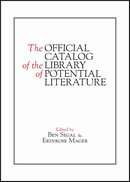 Potential is a dreamer’s word, an ideal state that may never be. Perhaps that’s what makes it a writer’s word. One searches for a potential mate, discerns potential careers and paths–the word implies an active state of searching and becoming. However, there’s also the disappointment of not meeting one’s potential, as in dating, there’s the oft-heard dismissal, “(s)he had such potential.” In literature, the word is usually associated with Oulipo (ouvroir de litterature potentielle, or “workshop of potential literature”) where constraints (often mathematical) were (and are) used to create new exceptions, deviations, derivations, or rather, new forms of literature.
Potential is a dreamer’s word, an ideal state that may never be. Perhaps that’s what makes it a writer’s word. One searches for a potential mate, discerns potential careers and paths–the word implies an active state of searching and becoming. However, there’s also the disappointment of not meeting one’s potential, as in dating, there’s the oft-heard dismissal, “(s)he had such potential.” In literature, the word is usually associated with Oulipo (ouvroir de litterature potentielle, or “workshop of potential literature”) where constraints (often mathematical) were (and are) used to create new exceptions, deviations, derivations, or rather, new forms of literature.
Potential has such possibility when untouched by the heavy hands of reality. In attempt to reify the energy of such fleeting states, Ben Segal and Erinrose Mager compiled The Official Catalog of the Library of Potential Literature, “a catalog of textual desire, of wished-for and ideal books,” that were dreamt of and desired by sixty-two writers, critics, and text makers. The homage to Oulipo is evident from the title, but also its aesthetic, with a spare white cover that resembles a French paperback, and its execution, which prizes the potential form. The entries are supposed book blurbs, but more frequently resemble narrative distillations from book jackets (only better), or stories unto themselves. If anything, this enhances the book but also reveals the liberties taken. In this catalog, the only constraint is the author’s imagination. The ideas are set out like seeds germinating on a windowsill before the final winter’s frost. They are unruly, ambitious, ready to unfurl.
The Official Catalog of the Library of Potential Literature is a book of books, and in some cases a catalog of catalogs, such as Matt Bell’s Big Book of Infinitely Impossible Timetables or Peter Markus’s Book of Sounds. Some titles are very literal (and amusing) like Teresa Carmody’s Literal: A Novel, which she describes as “Surprisingly true to life!” while others are intentionally misleading–How to Paint (imagined by Derrick Pell) was written by a lewd photographer who provides no such instruction.
Vanessa Place (also one of the contributors/wishers) commented during the Belladonna prose event at AWP that as an author she acts as a mirror for the reader, and that a reader’s response to a book only reveals the reader to her- or himself to a greater degree. In this sense, there are books that illuminate inner lives, that heal, that undo past harm, and offer guidance–including one for Diane Williams (suggested by Diane Williams), What Diane Williams Did and What She’ll Probably Do, With Useful Suggestions for Her. There are even more that injure. Bhanu Kapil warns, “Don’t read this book. Is it a bruise?” Robert Lopez imagines poems that assault like slipping on ice and cracking your skull.
It’s interesting to note the ways the wished-for books converge into categories. Many of the books transport the reader, but Aimee Bender’s literally changes her perspective, by rearranging her living room. There are adventure tales, stories packed with stock characters, including zombies, vampires, super models, cannibals, and race car drivers. Some books transform into poultices and contain elixirs, others are objets d’art and masterpieces of design, like Adam Robinson’s book within a wooden sculpture.
Add to the list political, fantasy, self-help, and practical books too, if you’re wondering which drugs to pair with certain video games. Surprisingly, there is no comedy, as a category. One author is trapped within the book and another is undone by the text, consumed. And, as a reader would expect from a catalog of potential literature, there are nods to the Oulipians. Laird Hunt conjures a tale about the French boxing league formed by Georges Perec after he fakes his death, while Craig Dworkin imagines Oulipian-like constraints for Cube, which can can be read both horizontally and vertically, as well as in strata, by way of lexical core sampling.
More than a few ideas, now born, beg to become. Shelley Jackson’s Slow Book is a story unto itself. Far more complex than a Kindle, The Slow Book is a book of the future, stored on a strip of coiled copper, that reveals one word per century, the word that defines the age. Lance Olsen imagines a manuscript that reads like David Lynch’s Lost Highway, it contains a poem that ignites with breath and others that dissolve upon exposure to light (and so much more). Artist and author Tom Phillips was so inspired by his idea he’s decided to make his book. I wouldn’t be surprised if others do too.
The Official Catalog of the Library of Potential Literature is a trove of ideas, ready for looting by writers, as well as a garden of delights for the reader. Jac Jemc describes a longed-for childhood fairy tale: “At the beginning, the author ties the finest narrative threads around your belly, and pulls you gently, but certainly, to the end.” Which is something so many of us have longed for in a book. If only wishing and imagination were readily transformed into the desired object, many of these books would already exist. But, as this book shows, there’s magic in the dream.









